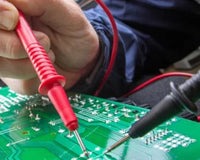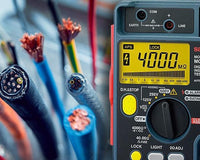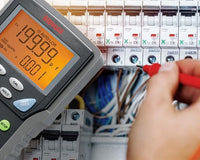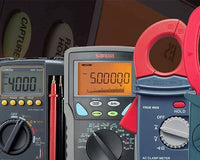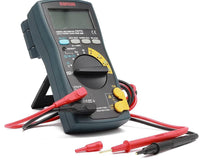SHOULD I BUY AN ANALOG MULTIMETER?
Also See:
A multimeter is an instrument that can measure a range of electrical properties. A standard multimeter can measure voltage, resistance and current, and is sometimes known as a volt-ohm-milliammeter (VOM) since it has a voltmeter, an ammeter and an ohmmeter. Some models can test for additional parameters like temperature and capacitance.
Multimeters are classified into two general types: Analog multimeters include a micro-ammeter and a moving pointer for displaying readings. Digital electronic multimeters with numeric displays have mostly replaced analog multimeters because they are less expensive, more precise and more physically robust.
Multimeter Uses
The most common parameter measured by a multimeter is volts. This is because most meters are used to find faults, and most problems exist on live circuits. Aside from the fundamental voltage, there are a range of other functions, and even multiple modes within those functions, that can help any technician or engineer become more proficient at his or her job.
It is utilized in various industries, including manufacturing, distribution and processing centers, lumber mills, industrial facilities, HVAC, residential and commercial electrical maintenance, and electronic installation. In Homes they may easily be used to check the voltage of wall outlets with a meter. If you turn off a breaker at the main panel and want to know which outlets are on that circuit, a meter might be a convenient tool. If you have a light bulb in a drawer, you can quickly test its functionality with a resistance meter. If it does, you can avoid tossing it out and paying a few bucks on a replacement bulb.
Types of Analog Multimeters
An analog multimeter is a form of permanent magnet moving coil (PMMC) meter. It operates on the d'Arsonval galvanometer principle. Its' main feature is an electromechanical display that indicates the measurement or reading with a needle or pointer on a printed scale.
Workings of an Analog MultimeterBecause the analog multimeter is a PMMC, when a current is passed through its coil, the coil travels in a magnetic field produced by the permanent magnet. The coil is connected to the pointer. When current runs through it, a deflecting torque acts on the coil, rotating it by an angle, causing the pointer to travel across a scale. The regulating torque is provided by a pair of hairsprings attached to the spindle.
Parameters Measured by Analog MultimetersA standard analog multimeter typically measures the electrical parameters listed below:
- DC Voltage
- AC Voltage
- DC Current
- Resistance
Comparison with Digital Multimeter
The most visible distinction between an analog and digital multimeter is that an analog multimeter uses a physical gauge with a printed scale and needle or pointer to show the value measured, and digital multimeters include a digital LCD display that immediately displays the numerical value.
A multimeter is normally used for routine electrical measurements. These adaptable instruments include a sensing device, auxiliary circuitry, and switches for measuring voltage, current and resistance across a wide range.
The majority of current multimeters include an electronic sensing device and a digital display. However, prior to the introduction of integrated-circuit electronics, the sensing device was electromechanical and displayed data in an analog format. Analog meters are less expensive, and analog displays are still extensively utilized for single-function applications.
The most significant differences between analog and digital multimeters between analog and digital multimeters are summarized below:
|
|
Analog Multimeter |
Digital Multimeter |
|
Reading |
Electromechanical Gauge |
Liquid Crystal Display (LCD) |
|
Calibration |
Manual Calibration |
Automatic Calibration |
|
Range |
Range Needs to be Set Manually |
Auto Ranging |
|
Accuracy |
Good |
Best |
|
Power Supply |
Not Needed |
Requires Power Source (Batteries) |
Reasons for Selection of Analog Multimeter
An analog or analog multimeter is a reliable workhorse in the electronics testing business. Analog multimeters have been in use for many years and are commonly referred to as VOA since they measure volts, ohms, and amps.
A noted advantage of analog multimeters is that the meter needle provides a continuous movement, making it is very easy to gain a fast idea of the order of magnitude, or of trends for slowly moving changes. This is not always so easy using a digital multimeter, and can be very useful in troubleshooting for automotive and other applications. Also, analog multimeters don't require batteries to function - always a plus.
Although analog multimeters are becoming less prevalent as digital multimeters, or DMMs, have become more common, analog meters are still very much available and can be found in laboratories, garages, workshops or at home. Analog multi-testers can perform admirably and produce accurate results for most common applications.
Also See:


